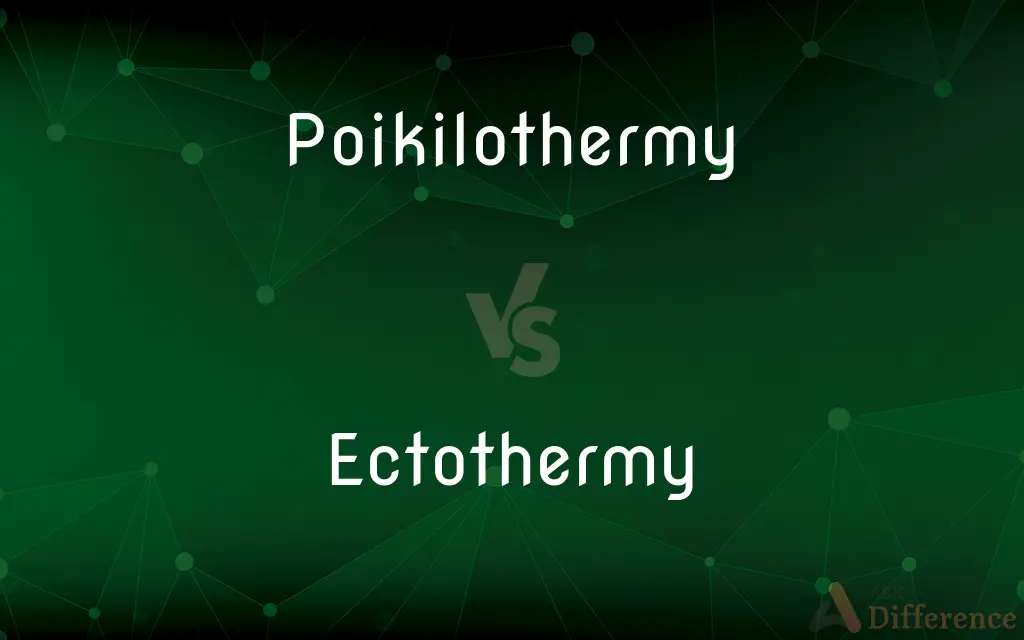Poikilothermy vs. Ectothermy — What's the Difference?
By Fiza Rafique & Maham Liaqat — Updated on April 24, 2024
Poikilothermy refers to animals whose body temperature varies with the environment, whereas ectothermy involves deriving body heat from external sources.

Difference Between Poikilothermy and Ectothermy
Table of Contents
ADVERTISEMENT
Key Differences
Poikilotherms are organisms whose internal temperature varies considerably, being largely dependent on ambient environmental conditions. While ectotherms also rely on external conditions for their body heat, their temperature can be more stable if they actively regulate it through behavior.
The term poikilothermy is often associated with fluctuations in body temperature that can be extreme, depending on the external temperatures. On the other hand, ectothermy generally involves a more consistent approach to managing body temperature, albeit still dependent on external sources, like basking in the sun or seeking shade.
Poikilothermic animals include many fish, reptiles, amphibians, and invertebrates that do not maintain a constant body temperature. Whereas ectotherms include similar types of animals but highlight their ability to regulate temperature through external means rather than internal physiological processes.
In poikilothermy, the variability in body temperature can affect the organism's metabolic rate, which fluctuates with its body temperature. In contrast, ectotherms often use behavioral adaptations to moderate their exposure to temperature extremes, thus maintaining a more stable metabolic rate.
Despite the overlap, poikilothermy and ectothermy are distinct in focusing either on the fluctuating nature of body temperature or the source of the heat (external), respectively, which guides how these animals interact with their environments.
ADVERTISEMENT
Comparison Chart
Definition
Body temperature varies significantly with the environment.
Body temperature is regulated by external sources.
Temperature Stability
Highly variable.
Relatively stable through behavioral regulation.
Typical Organisms
Many fish, reptiles, amphibians.
Similar, but includes active temperature regulation.
Metabolic Impact
Metabolic rate changes with temperature.
More stable metabolic rate through behavior.
Heat Source
Environmental temperature directly influences body heat.
External heat sources are utilized for warmth.
Compare with Definitions
Poikilothermy
A condition of varying internal body temperature depending on environmental conditions.
In poikilothermy, a lizard's body temperature drops at night as the air cools.
Ectothermy
Involves behavioral adaptations to manage body heat.
An ectothermic animal might burrow into the ground to escape midday heat.
Poikilothermy
Associated with environmental adaptations rather than internal regulation.
Amphibians use poikilothermy to survive in varied climatic conditions.
Ectothermy
Common in reptiles, amphibians, and many fish.
Turtles use ectothermy to maintain their body temperature by moving between sun and shade.
Poikilothermy
Characteristic of many ectothermic animals where internal physiological temperature control is minimal.
Fish in cold waters exhibit poikilothermy by having body temperatures close to the surrounding water.
Ectothermy
A physiological trait where an organism relies on external heat sources to regulate body temperature.
Snakes bask on rocks in the sun as part of their ectothermic behavior to warm up.
Poikilothermy
Common in invertebrates and cold-blooded animals.
Insects, being poikilothermic, are more active in warm environments.
Ectothermy
Utilizes environmental heat but does not fluctuate as extremely as in poikilotherms.
Even in fluctuating temperatures, ectotherms manage to maintain relatively stable body heat through behavioral strategies.
Poikilothermy
Leads to a fluctuating metabolic rate based on ambient temperature.
A poikilothermic animal may slow down significantly in colder temperatures.
Ectothermy
Helps maintain a more stable metabolic rate than poikilothermy.
By regulating exposure to heat, ectotherms can stabilize their metabolic functions.
Poikilothermy
An organism, such as a fish or reptile, having a body temperature that varies with the temperature of its surroundings.
Common Curiosities
How do ectotherms regulate their body temperature?
Ectotherms use behaviors such as basking in the sun or seeking shade to control their temperature.
Can an animal be both poikilothermic and ectothermic?
Yes, many animals are both poikilothermic and ectothermic, as these terms describe different aspects of temperature regulation.
How do poikilothermic animals survive extreme temperatures?
They adjust their activity levels and metabolic processes based on the ambient temperature.
What are the advantages of ectothermy?
Ectothermy allows for energy conservation as less energy is spent on heating the body internally.
Are all reptiles ectothermic?
Yes, all reptiles are ectothermic, relying on environmental heat sources to regulate their body temperature.
How does poikilothermy affect an animal's activity?
Activity levels in poikilothermic animals often correlate with external temperatures—warmer conditions increase activity.
Which animals are typically poikilothermic?
Many reptiles, amphibians, fish, and invertebrates are poikilothermic.
Is poikilothermy more common in specific habitats?
Yes, poikilothermy is more common in aquatic and temperate environments where temperature fluctuations are frequent.
What is poikilothermy?
Poikilothermy is when an organism’s body temperature varies significantly with environmental conditions.
What is ectothermy?
Ectothermy is a physiological feature where an organism depends on external environmental heat sources to regulate its body temperature.
How does the environment affect a poikilothermic animal?
Environmental temperatures directly influence the physiological processes of poikilothermic animals.
What are some examples of ectothermic behavior?
Examples include sunning to increase body temperature or hiding in the shade to cool down.
What role does behavior play in ectothermy?
Behavioral adaptations are crucial in ectothermy for maintaining optimal body temperatures.
Why don't ectotherms maintain as stable a temperature as endotherms?
Ectotherms rely on external heat sources which can vary, unlike endotherms which generate most of their body heat internally.
How do ectotherms handle cold environments?
Ectotherms may hibernate or burrow to escape the cold, reducing their metabolic needs until warmer temperatures return.
Share Your Discovery

Previous Comparison
Canon vs. Cannon
Next Comparison
Ere vs. ErrAuthor Spotlight
Written by
Fiza RafiqueFiza Rafique is a skilled content writer at AskDifference.com, where she meticulously refines and enhances written pieces. Drawing from her vast editorial expertise, Fiza ensures clarity, accuracy, and precision in every article. Passionate about language, she continually seeks to elevate the quality of content for readers worldwide.
Co-written by
Maham Liaqat













































